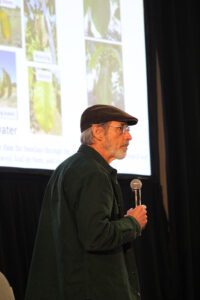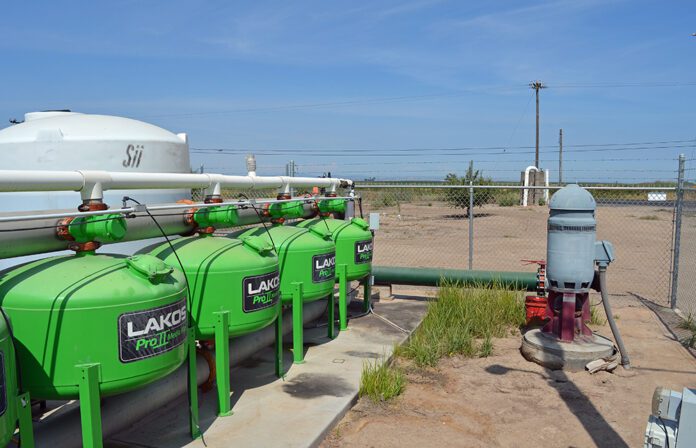UC Davis Professor Ken Shackel reviewed some basics for walnut and almond growers to time and measure irrigation sets to improve water use efficiency and crop quality. Shackel, in a talk on irrigation advancements in walnut and almond at the North Valley Nut Conference in January, reiterated findings of a 10-year study on delaying irrigation onset in walnut.
The study was instated after Shackel talked with a Red Bluff grower situated along the river who expressed worry over the visible stress on his trees when water was halted before harvest. This prompted speculation that perhaps insufficient water was provided throughout the season, leading to water depletion. Concurrently, he noted concerns that initiating irrigation too early in spring might induce symptoms such as dark kernels and leaf issues.
“So, we thought, even though the trees are stressed at harvest, maybe, actually, you were putting too much water on,” he said.
A 2014-24 delay trial tested, rather than matching the full evapotranspiration (ET), which starts with leaf-out in April and gets close to 40 inches in the season, holding off on irrigating until trees show stem water potential (SWP) that is at least a little drier (about 2 bars) than the fully irrigated baseline.
“We said, ‘Maybe what we want to do is wait to start irrigating whenever it occurs until the trees are a little bit drier than what we call the fully irrigated baseline,’” he said.
What researchers found was instead of starting in mid-April, they were able to delay until May or June for the first irrigation, which is when weather starts to heat up.
“The first time we did this, the grower was very nervous because everybody else was irrigating and it was hot, but we were measuring the trees and they were okay,” he said.
Shackel shared a graph showing the average over 10 years comparing the experiment in the Red Bluff orchard with a standard grower’s orchard. In addition to delaying the irrigation, data revealed the grower didn’t actually apply anywhere near 100% of water ET to the trees.
“The reason why we were able to delay as well as not keep up with ET during the season, was that our delay was based on what the grower did, once we turned on the valve, we just let the trees get what the grower got,” he said. “Usually after the first year after the experiments, the grower changed what they did and they delayed some and didn’t go all the way up to full ET, and the reason why was, typically, our trees looked just as good or better than their trees.”
Shackel also shared results from a trial that began in 2019 on a walnut orchard in Yuba City which showed every inch of rain in the winter from December to April allows a grower to start irrigating about two days later. He noted two days was a ballpark number, and they would ideally like to do more complete studies, but said the results were impressive.
When examining fertigation on the trials, he said it’s okay to fertigate without starting to irrigate.
“Just because you think it’s dry or just because your neighbors are irrigating, or you need to fertigate, doesn’t mean you have to start irrigating in earnest,” Shackel said. “I think we can make a practical conclusion that waiting for two to three bars below the baseline is a safe practice.”
In terms of yield and quality on the trials, he said it was kind of a wash.
“There’s not a lot of difference; we get a little improvement in quality on the delayed trees, but it’s hard to measure,” he said.
A Patterson orchard showed the same thing was happening, until 2022, when it yielded a substantial reduction at 18%, but ended up 11% over the control the following year.
Shackel’s take-home message for walnut growers is it’s probably not a good idea to start irrigation right at leaf-out to avoid root health issues, and it’s best to allow soil to dry, particularly after a wet winter, which will both save water and result in healthier trees.

Measuring SWP in Almonds
Even under normal water availability conditions, there are benefits of water stress in almonds during hull split and a lot of reasons growers might want to consider cutting back on irrigation during that window, according to Shackel. Those reasons include speeding up hull split, reducing hull rot due to the sped-up process, reducing the navel orangeworm period, a reduction in sticktights, which improves harvestability, and saving water. 14 to 18 bars SWP during hull split is recommended in order to obtain those benefits.
Shackel said he’s often asked why he can’t just tell growers how much to irrigate, and he said it comes down to what kind of soil you’re on and why you need to measure SWP, especially for deficit irrigation. Referring to an orchard on the same irrigation line but planted on two different soil types, he said, is a really good example of why trees on two different soil types on the same irrigation line can show two very different outcomes of stress.
“It’s really hard to say how much irrigation; you have to at least try to check the trees to kind of calibrate what that means for your soil and your situation,” he said.
When determining how much water might be needed at a given time, Shackel said he’s often asked if there are any good, automated ways to use a pressure bomb or pressure chamber, which measures SWP. After spending a good amount of his career looking at alternatives to the pressure chamber, he said good options include the FloraPulse sensor and the Saturas sensor, which both measure the same thing.
But measuring SWP in an automated way has never been simple, he said.
“It’s amazing that the pressure chamber, as old as it is, is still doing the job,” Shackel said.
He noted there have been some recent developments around other devices that measure additional things that might be related to SWP, including one that measures the shrinking and swelling of the trunk, and a sensor that plugs into the tree and is designed to measure the gallons of water used by the tree.
“So, the important thing here is which ones are reliable enough to do the job to tell you when to irrigate,” he said.
Ultimately, he said the two he worked with that measure SWP reliably are the pressure bomb and the FloraPulse SWP sensor.
He said that last year’s stress treatment results in almond showed fully automated, plant-based irrigation control is possible with a reliable measure of plant stress, and the two devices showed a one-to-one line between what the pressure chamber says and what the sensors say.
“This is what’s very important: If you have something reliable, then it can actually be used to monitor water and control water,” he said.
In last year’s test, Shackel said he had two stress treatments on almond trees, a moderate stress treatment with a goal of 20 bars and a severe stress treatment with a goal of 25 to 30 bars.
“Trees kind of get relaxed during the night because there isn’t much demand on them, and then during the day, they dip down because they’re sucking water out of the soil,” he said. “And that’s what this measures, and it measures it really accurately.”
Shackel suggests tackling the issue of too much water in walnut and too little water in almond comes down to delaying irrigation to mitigate excessive water in walnut while reducing water for almond during hull split. He also anticipates automated management advancements are on the horizon and emphasized SWP holds the promise of dependable irrigation management for both crops.

Kristin Platts | Digital Content Editor and Social Correspondence
Kristin Platts is a multimedia journalist and digital content writer with a B.A. in Creative Media from California State University, Stanislaus. She produces stories on California agriculture through video, podcasts, and digital articles, and provides in-depth reporting on tree nuts, pest management, and crop production for West Coast Nut magazine. Based in Modesto, California, Kristin is passionate about sharing field-driven insights and connecting growers with trusted information.
















